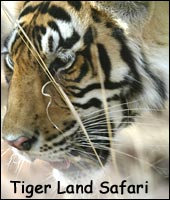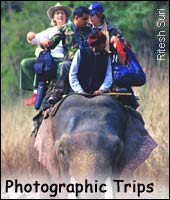HOME : Species of India - Deer Family of
India
DEER FAMILY OF INDIA
Deer are the most ancient of all the ruminants ( cud chewing animals) and are mostly found in the forests or in the open grasslands. Even though they are part of Bovidae still there are many distinctions which separate them from this class. Nearly all the deer species have large fissure below each eye and the gall bladder is absent in nearly all the deer’s. Unlike other ruminants (cud chewing animals) deer have solid horns and that is its most distinguishing factor. Deer antlers are mass of solid bone and are shed on regular intervals and regrow again. Whereas in all other bovidae’s the horns are permanent and are not shed.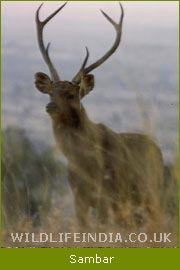
India has a distinction of having the largest number of deer species in the world. The species found in India varies in size as per the areas they live in.
The horn or the antler is the most important and fascinating part of a deer. The process starts gradually and with each shedding it grows more and finally takes its shape. During the growing of the antlers a soft shining skin covers the antlers and is known as “velvet”. This skin is highly sensitive as it is fed by many blood vessels and can be injured easily.
When the antlers grow to take their final shape a ring of bone forms on the base and cuts off the supply of blood to the velvet thus leading to its shedding. During this period many deer can be seen rubbing their antlers on the tree trunk to get rid of the velvet. Shedding of velvet is usually followed by the period of rutting and many stags are seen sparing with each other to get hold of hinds. These fights are mostly jostling with each other antlers interlocked and are rarely fatal. The shedding of antlers is mainly after the finish of the rutting season. One factor playing important role in the shedding of horns is the availability of good grass. For males good intake of food means good source of calcium which helps in the formation of bone (antlers) whereas for female this period acts as a good source of nutrients to nurse the young ones.
The surroundings play very important role in the body development of deer species. Deer species of central India are known for their large size and big antlers. Whereas the species found in Eastern and Southern India have antlers smaller in size. The difference in habitat of swamp deer has led to the development of two sub species, hard ground and soft ground barasingha. The swamp deer and the sambar have large funnel shaped ears to catch maximum sound as both inhabit denser parts of the forests. Whereas the chital has short ears as it inhabits the fringes of the forest and open grasslands where catching sound is much easier.
Deer have profound effect on their surroundings and every type of deer plays a very important role for Nature. They keep a control on the growth of grass and other tree types which are favored by them.
The Swamp Deer or the Barasingha (Cervus duvauceli)
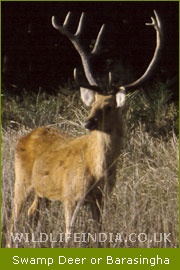
One of the most remarkable come backs made by any animal species from the brink of extinction the Barasingha’s is a role model for the conservationists.
The coat of this magnificent deer is golden yellow and the stags are maned and slightly dark in color. The adult males have large and widely flared set of antlers sometimes with 10-14 points.
In India there two races of the is deer found: one is the swamp inhabiting and is found mainly in the Terai region of U.P., small numbers in the Hastinapur Wildlife Sanctuary and more recently discovered herd in Jhilmil Jheel in Uttaranchal.and as well as in Assam. The other race is the Hard Ground one found only in Madhya Pradesh.
The Barasingha of the swamps of terrain are mainly found in the small islands of reed and grass in the swamps and can be easily recognized by their splayed hooves ideally suited for movement on soft spongy surface. They hardly come out of the water. The hard ground barasingha is found in the open grasslands of Kanha National Park and have smaller well knit hooves adapted to run on hard ground. Swamp deer’s can be seen feeding during the day time and rest only when it is too hot to remain in the open. Their sense of smell is very high.
The herds of Swamp Deer can be seen in mixed numbers throughout the year but during the period of rutting season they form exclusive breeding herds. After the breeding, stags sometime leave the herds to form stag herds.
Swamp deer rarely use tree bark to peel off the velvet from their antlers instead the long grass of their habitat suits their requirement.
The Sambhar (Cervus unicolor)
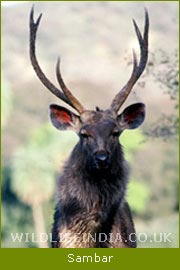
Sambhar is the largest of all deer species found in the Indian Sub-continent. It also has the finest pair of antlers sometimes reaching a length of around 40 inches. A full grown adult stag can reach a weight of 300 kg.
It is mainly a forest dweller and prefers hills and denser parts of the forest. In India Sambhar is found from the lower ranges of Himalayas to the forests of south India, from the forests of Rajasthan to the forests of north east India.
The color of the coat is mainly brown with greyish tinge. The coat is mainly shaggy and coarse and in summers the hair fall down. The older stags are very dark in color almost looking black.
Sambhar prefers to live in the denser parts of the forest and likes to feed on leaves, wild fruits and grass. They are extremely shy of humans and usually feed during the later part of the evenings and in night. The sense of hearing is very acute in Sambhar and they are helped in this by their large funnel shaped ears. On seeing a predator a Sambhar gives a honking bark which is repeated as long the predator is seen. In spite of its size Sambhar are very nimble in moving through thick undergrowth without making much noise. They are also very good swimmers and can be seen in the waters especially in the lakes of Ranthambore.
The shedding of antlers takes place mainly in March end till mid April.Sambhar s prefer to come to same tree again and again for rubbing off the velvet from the antlers. The antler size varies in between the Sambhar found in Madhya Pradesh and the ones found in the forests of North east India.
Sambhar's have the largest and very well developed facial glands to attract the females by secreting scent and leaving the marks on the tree trunks. The fight between two stags is mainly for protecting the territory and rarely for the females. The mating takes place mainly in November and December and the young ones are born on the onset of rains when the forest is dense and the grass is high. Males prefer to live alone and separate from hinds as soon as the mating is over.Sambhar's always move around in small herds with hinds and young stags normally seen together.
The Chital or the Spotted Deer (Axis axis)
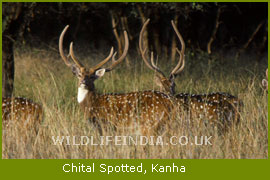
As the name suggest Chital has bright spots on its body. Out of the deer species Chital is the most beautiful of them. Its coat has shining rufous-fawn color with bright white spots all over the body and hardly changes color even in summers.
In India Chital is very widely distributed from the base of Himalayas to the steaming forests of the south except in the north east. It inhabits the fringes of the forests and prefers to graze in the grasslands. Any place with good grazing ground and plentiful water will have the presence of Chital.
Chital are always seen in herds numbering 20-30 and will have many stags. In many areas very big herds sometimes numbering hundreds have been seen together. They are known to raid the cultivation fields especially in areas which are adjacent to the forests and cause heavy damage to the crops. The best species of Chital can be found in the terai region in the foothills of Himalayas and in Madhya Pradesh.
Out of all deer Chital are most sociable animal. They can be easily seen in the company of other deer species inhabiting the same forest. A very special relation ship worth mentioning is between langur monkeys and the Chital. Where ever langurs feed on the trees, chital can be seen feeding on the leaves and tender shoots which the monkeys drop on the ground. This relationship also acts as an advance warning system against the arrival of predators. On seeing a predator langurs give alarm call which makes the deer on the ground alert against the danger.
The rutting season differs in Chital according to the areas they inhabit. In the northern areas of India they tend to breed in winters and in warmer areas of Madhya Pradesh they mate in summer months. The rutting call of an adult stag is a loud bellow and quite often fierce fight between two stags can be seen for possession of hinds. There are no territorial fights in Chital, the fights when happens are mainly for protecting the doe from other stags.
As Chital are preyed by virtually all the predators they have a very prolific breeding cycle and give birth to young one every six month. In the wild a hind can be seen with two or sometimes three young fawns all of different ages.
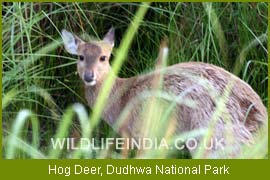 The Hog Deer (Axis porcinus)
The Hog Deer (Axis porcinus) A deer quite related to the Chital it is smaller and more stoutly built then the Chital. Hog deer as named has a peculiar habit of running like a hog with its head down without the traditional leaps of a deer.
Hog deer has a long body with shorter legs and the color of the coat is brown to dark brown with reddish tinge. It has white inner ears and white under tail. There are white tips on some hair which sometimes give it a spotted look. The summer coat is usually paler in color. The antler size is also considerably smaller as compared to Chital.
In India, Hog Deer inhabits the alluvial grasslands of the terai forest right from Corbett to the forests of Assam.
Hog deer favors the grass and reeds along the river banks, the grass covered riverine islands and open grass lands. Hog deer are mainly solitary animals and very rarely they are found in two’s or three’s. They can be seen frequenting similar areas for days together for feeding. The afternoon’s are always for resting and grazing is in the early mornings and evenings. Being the creatures of open, Hog deer have very acute sense of sight, smell and sound.
As with other deer species, the young ones are born during the time when rain starts and the grass grows long enough to hide the fawns.
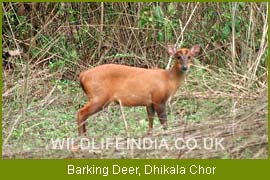 The Muntjac or the Barking Deer (Muntiacus muntjak)
The Muntjac or the Barking Deer (Muntiacus muntjak) A smaller deer as compared to Chital, Sambhar and even a Hog deer, the Muntjac has small set of antler consisting of short brow-tine and an unbranched beam. The coat is reddish brown in color. An adult male Muntjac or the Barking Deer has very well developed canines which can be used as a weapon of self defense.
In India Muntjac are found all over India with three distinct species recorded. The species found in North India has a brightest coat from others.
Muntjac or the barking deer prefers denser parts of the forest and can be seen in pairs or smaller family groups. They are found mainly on the hilly slopes and can be seen till the heights reaching 8-9,000 ft. As with other deer species Muntjac also have scent glands beneath their eyes and in addition they have an additional gland on their forehead. These glands secrete fluid especially during the mating and are means of attracting the hinds. These are very helpful for deer which inhabit the dense forests. Muntjac feeds on leaves, grass and wild berries and fruits. When alarmed they give a short dog like bark before bounding away. The rutting mainly takes place during winters and young ones are born on the onset of rains.
Other than above deer India also has following deer species. We have not mentioned in detail about these deer as they are found in relatively remote areas and are also very difficult to see. It requires a complete expedition to go to these places and to see these species.
Hangul or the Kashmir Stag (Cervus elaphus hanglu)
A deer species more related to the Red Deer found commonly in Europe, Hangul is found in the valley of Kashmir especially in areas above Srinagar called Dachigam.
The summer coat of Hangul is spotted and has flecks of pale hair and sometimes the coat is dappled with white. This provides them with adequate protection with the surroundings. In the winter the color of the coat becomes more uniform and merges well with the winter landscape.
Hangul is greatly influenced by the change in the season and its movement becomes migratory with the onset of summers and winters. Hangul stags like to move around in their territories and come to the hinds only during the time of rutting. The young ones are taken care of by the hinds throughout the time they are with their mothers. The rutting territory in Hangul is less as compared to other big deer as the number of hinds is more in Hangul. The rutting starts in October and the fawns are born in late May.
The Thamin or Brow-Antlered Deer (Cervus eldi)
This deer is also called the Dancing Deer due to its delicate style of walking. The males usually reach height up to 4 ft and the hinds are smaller in size. The color of the coat in stags is nearly black and the one of hinds is fawn. In appearance it looks similar to Sambhar but is smaller in size.
In India this deer is found only in Manipur in Eastern India and that also on the Shore of Loktak Lake. The most distinctive feature of Thamin is its antlers which have tines from 2 to ten and can reach a length of 2 meter. The antlers of this deer are most impressive of all the deer species. They grow outwards and then turn inwards. The brow tine is specially long and distinct hence the name Brow-Antlered Deer.
Thamin prefers open woodland, scrubs and undulating land near the rivers and the marshland. Due to its proximity to the cultivation land they tend to raid the crops. With continued encroachment on their land by the humans the Thamin is now confined to a small area in Loktak Lake. They mainly feed on water plants, grasses, shoots and crops.
The rutting takes place between March and April and after a gestation period of 220-250 days the young one is born. The stags leave the herd after the rutting and are seldom seen with herds till the time of next rutting.


